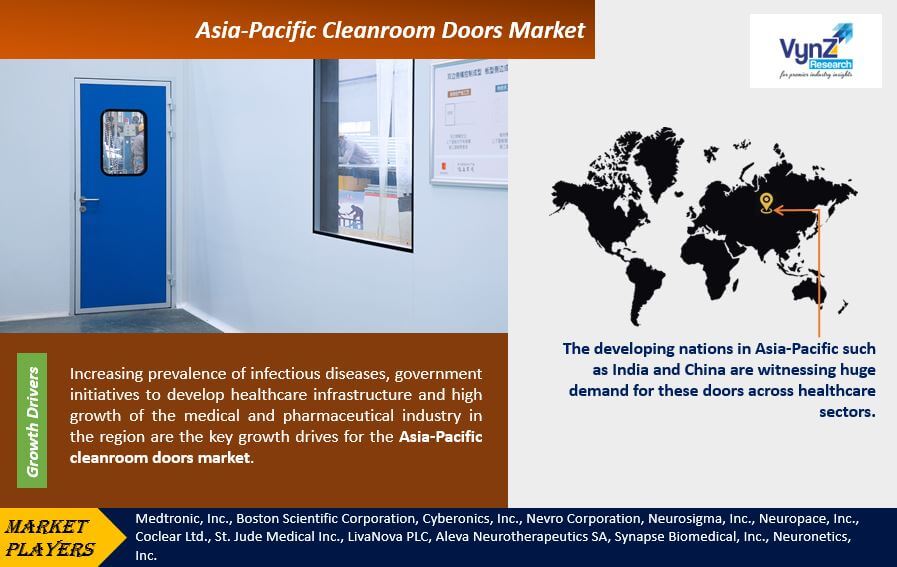| Status : Published | Published On : Dec, 2023 | Report Code : VRHC1187 | Industry : Healthcare | Available Format :

|
Page : 102 |

Asia-Pacific Cleanroom Doors Market – Analysis and Forecast (2025-2030)
Industry Insights by Product (Swinging Doors, Roll-up Doors, Sliding Doors, Others), by Mode of Application (New Construction, Aftermarket) by End User (Academic Research Institutes and Laboratories, Biotechnology, Pharmaceutical, and Medical Device Industry, Hospitals, Diagnostic Laboratories, Others), and Asia-Pacific Region (China, Japan, South Korea, India, Singapore, and Rest of Asia-Pacific)
Industry Overview
The Asia-Pacific Cleanroom Doors Market will generate more than half a billion in revenues by 2030, growing at a CAGR of 5.9% during the forecast period. The Asia-Pacific market is primarily driven by technological advancements in the industry, high demand from the growing pharmaceutical and medical device industry, and increasing demand for aftermarket services. With the increasing regulatory compliances in the region, the demand for cleanroom swinging, sliding, and roll-up doors are anticipated to create huge demand in the coming years.

Asia-Pacific Cleanroom Doors Market Segmentation
Insight by Product
On the basis of product, the market is categorized into swinging doors, roll-up doors, sliding doors, and others. Swinging doors hold the largest share in the market and are also anticipated to witness considerable growth during the forecast period. Different companies are proving customization services in terms of manufacturing the doors based on material, panel designs, interlocking systems. This offers buyers with the desired product, which meet their CGMP guidelines, thus fueling the growth of the Asia-Pacific cleanroom doors market.
Insight by Mode of Application
There are two modes of application in the market which includes new construction and aftermarket. New construction mode of application account for the larger revenue share in the Asia-Pacific market and the aftermarket of cleanroom doors is anticipated to witness higher growth in demand during the forecast period.
Insight by End-User
Academic research institutes and laboratories, biotechnology, pharmaceutical, and medical device industry, hospitals, and diagnostic laboratories are the major end users of cleanroom doors market. Biotechnology, pharmaceutical, and medical device industry altogether account for the largest demand for cleanroom doors across the healthcare sector. Pharmaceutical and medical device companies have to comply with goods and manufacturing practices set by the regulatory authorities, thus leading to high growth in the cleanroom doors market.
Asia-Pacific Cleanroom Doors Market Report Coverage
|
Report Metric |
Details |
|
Historical Period |
2018 - 2023 |
|
Base Year Considered |
2024 |
|
Forecast Period |
2025 - 2030 |
|
Market Size in 2024 |
U.S.D. xx.x Billion |
|
Revenue Forecast in 2030 |
U.S.D. More than half a billion Billion |
|
Growth Rate |
5.9% |
|
Segments Covered in the Report |
By Product, By Mode of Application and By End User |
|
Report Scope |
Market Trends, Drivers, and Restraints; Revenue Estimation and Forecast; Segmentation Analysis; Impact of COVID-19; Companies’ Strategic Developments; Market Share Analysis of Key Players; Company Profiling |
|
Regions Covered in the Report |
China, Japan, South Korea, India, Singapore, and Rest of Asia-Pacific |
Industry Dynamics
Asia-Pacific Cleanroom Doors Market Growth Drivers
The increasing prevalence of infectious diseases, government initiatives to develop healthcare infrastructure and high growth of the medical and pharmaceutical industry in the region are the key growth drives for the Asia-Pacific cleanroom doors market. Moreover, the high prevalence of hospital-acquired infections (HAIs) in Asia-Pacific is leading to more stringent norms regarding cleanrooms in hospitals. Healthcare providers in the region are now adopting technologically advanced, and automatic door systems for their cleanrooms. This is anticipated to create huge demand for cleanroom doors in the region in the next few years.
Expanding Healthcare and Pharmaceutical Sector: The Asia-Pacific region is witnessing rapid growth in the healthcare and pharmaceutical industries. Cleanrooms are essential in these sectors to maintain sterility and prevent cross-contamination during manufacturing, research, and development processes. The demand for cleanroom doors in hospitals, pharmaceutical manufacturing facilities, and research laboratories is expected to increase significantly.
Growing Electronics and Semiconductor Industry: The Asia-Pacific region is a hub for electronics and semiconductor manufacturing. These industries require cleanroom facilities to ensure the quality and reliability of electronic components and microchips. Cleanroom doors play a crucial role in maintaining cleanliness and controlling environmental factors such as temperature, humidity, and particulate contamination.
Asia-Pacific Cleanroom Doors Market Challenges
The fluctuating raw material prices, high cost of advanced door systems, and difficulty in implementation of regulatory standards are some of the key challenges to the growth of the cleanroom doors market.
Cleanroom doors require precise installation and regular maintenance to ensure their optimal performance. The installation process involves careful sealing and integration with the cleanroom wall systems. Similarly, proper maintenance, including regular cleaning and inspection, is essential to prevent contamination risks. The complexity of installation and maintenance can be a challenge for end-users who may not have the necessary expertise or resources, leading to potential operational issues.
Asia-Pacific Cleanroom Doors Market Industry Ecosystem
In Asia-Pacific, several local players are competing with global players by providing low-cost doors. However, high regulatory compliance and stringent manufacturing processes create challenges for local players to compete against global players with years of experience and advanced technology.
Asia-Pacific Cleanroom Doors Market Geographic Overview
Geographically, Japan is the largest cleanroom doors market as the country has advanced healthcare infrastructure, high regulatory standards and high emphasis on high-quality products. These factors lead to the high demand for cleanroom doors in Japan across the life sciences industry.
Moreover, the developing nations in Asia-Pacific such as India and China are witnessing huge demand for these doors across healthcare sectors. Increasing healthcare expenditure, growing medical device and pharmaceutical industry, and increasing regulatory compliances in these countries will lead to an increase in demand for these doors in these countries. Local manufacturers in these countries are also catering to the demand in the market by providing low-cost products within these countries.
Asia-Pacific Cleanroom Doors Market Competitive Insight
Assa Abloy AB is a Swedish Group who offers products and services related to locks, gates, doors and entrance automation. Products and services include controlling access and confirming identities with keys, mobile, cards, tags and biometric identity verification systems.
Dortek specialises in the design, manufacture and installation of advanced hygienic GRP doors.
Gandhi Automations Pvt Ltd., Dortek, GMP Technical Solutions Private Limited, ASSA ABLOY, Terra Universal Inc., ASI Doors Inc., Nicomac Srl, Rite-Hite, Avians, Chase Industries, Inc., and EFAFLEX are the key players offering cleanroom doors in Asia-Pacific.
Recent Developments by Key Players
ASSA ABLOY has acquired Messerschmitt Systems, a German developer and manufacturer of access control hardware and software solutions for the hospitality market including products for access control and in-room control.
Nicomac has joined the Mangini creating a new entity in Italy for the cleanroom and OSD equipment market.
The Asia-Pacific Cleanroom Doors Market report offers a comprehensive market segmentation analysis along with an estimation for the forecast period 2025–2030.
- By Product
- Swinging Doors
- Roll-up Doors
- Sliding Doors
- Others
- By Mode of Application
- New Construction
- Aftermarket
- By End User
- Academic Research Institutes and Laboratories
- Biotechnology, Pharmaceutical, and Medical Device Industry
- Hospitals
- Diagnostic Laboratories
- Others
Geographical Segmentation
- Japan Cleanroom Doors Market
- By Product
- By Mode of Application
- By End User
- China Cleanroom Doors Market
- By Product
- By Mode of Application
- By End User
- India Cleanroom Doors Market
- By Product
- By Mode of Application
- By End User
- Australia Cleanroom Doors Market
- By Product
- By Mode of Application
- By End User
- South Korea Cleanroom Doors Market
- By Product
- By Mode of Application
- By End User
- Rest of Asia-Pacific Cleanroom Doors Market
- By Product
- By Mode of Application
- By End User
PRIMARY RESEARCH INTERVIEWS - BREAKDOWN
.png)
Frequently Asked Questions
Purchase Options
Latest Report
Research Methodology
- Desk Research / Pilot Interviews
- Build Market Size Model
- Research and Analysis
- Final Deliverabvle
Connect With Our Sales Team
- Toll-Free: 1 888 253 3960
- Phone: +91 9960 288 381
- Email: enquiry@vynzresearch.com
Asia-Pacific Cleanroom Doors Market
